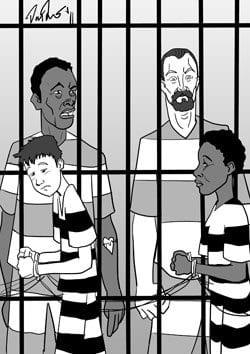
Cruel and unusual
News reports of horrendous crimes committed by teenagers have shocked the public. Years ago bad boys were guilty of little more than petty theft and disturbing the public. Now the criminal repertoire includes serious assault and murder.
It was once generally agreed that youthful offenders would be prosecuted in juvenile court. In 1974 the U.S. Congress passed the Juvenile Justice and Delinquency Prevention Act to encourage the states to do so. An amendment in 1980 made it unlawful, except under special circumstances, to incarcerate a youthful offender in an adult facility.
Nonetheless, prosecutors have found ways to circumvent those restrictions. According to reports there has been a 208 percent increase since the 1990s of youth offenders being held in adult facilities. There was an effort in the U.S. Senate in 2009 to close the loopholes in the law but the U.S. House has not acted on the issue.
People were satisfied that violent youthful criminals should be subjected to the harsher conditions of the adult prison system. Little did they realize that thousands of non-violent young offenders were also being confined with adults.
The Campaign for Youth Justice (CYJ), a Washington, D.C. group to advocate for youthful offenders, has studied the data and found that “tens of thousands of young people end up in the adult system for non-violent offenses.” For example, they found that “the vast majority” of the 8,000 young people in Connecticut’s adult criminal system have been arrested for non-violent offenses.
Another major problem is that youth arrested for non-violent crimes are often held in jails with adult offenders even before they are convicted. These are decisions not even made by a judge to determine whether such incarceration is appropriate or even lawful.
According to the CYJ studies, “youth in adult prisons are at risk of abuse, sexual assault, suicide and death …” Studies also indicate that the incarceration of youth in adult prisons does not promote public safety. There is no evidence that such imprisonment reduces the rate of recidivism.
A provision of the Juvenile Justice and Delinquency Prevention Act proscribed disproportionate minority confinement. Nonetheless the CYJ found that in some states minority youth were disproportionately prosecuted as adults. In Illinois only a third of the youth population are minority, but in some jurisdictions they represented 90 percent of the youth in the adult system. As one might expect, the data from southern states is equally disturbing.
Common sense would indicate that adult prisons can function as a graduate school for felons. It is not the place for youthful offenders who are capable of being rehabilitated. The CYJ proposes that states spend more effort and resources on improving the quality of the juvenile justice system.
The public must be protected from pathologically violent felons of whatever age. But the criminal justice system must be attuned to rehabilitating those still of tender years. The confinement of youthful offenders in adult prisons could violate the constitutional prohibition against “cruel and unusual punishment.”


![Banner [Virtual] Art Gallery](https://baystatebanner.com/wp-content/uploads/2024/04/Cagen-Luse_Men-at-store-e1713991226112-150x150.jpg)



